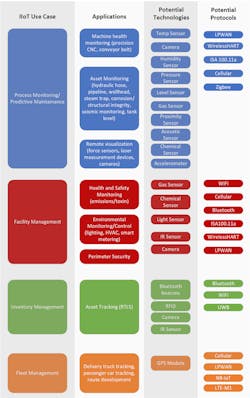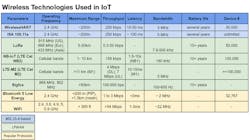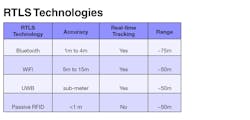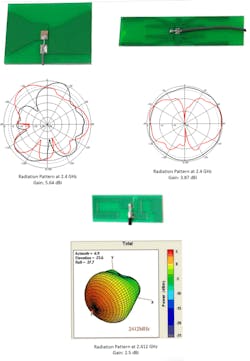Understanding the Underlying Sensor and Wireless Technologies in IIoT Apps
This article appeared in Microwaves & RF and has been published here with permission.
From the connected home and smart wearables to Industry 4.0 and smart-city applications, wireless sensor networks (WSNs) permeate nearly every conceivable application. They bring automation to simple manual tasks with remotely controlled actuators and monitoring/tracking environments with evolving microelectromechanical-systems (MEMS) sensors. These relatively simple, energy-constrained devices reveal a massive potential in data collection and data analytics to better assess human, machine, and even plant systems.
In industrial IoT (IIoT), short-range wireless solutions, cellular, and low-power wide-area networks (LPWANs) can be leveraged to support the various sensor nodes. The choice of industrial communications depends on whether the process is time-critical with the need for real-time data or is non-time critical with either frequent or infrequent transmissions. Depending on the industrial application at hand, there are numerous IIoT use cases in which many sensor technologies and/or communication protocols may be brought to bear (Fig. 1).
Process Monitoring
Process monitoring is likely to be the largest application for industrial WSNs (IWSNs) as it requires the placement and tracking of thousands to tens of thousands of sensor nodes over vast distances. This centralized method of tracking industry operations is what leads to realizing predictive maintenance strategies that systematically minimize factory downtime and save on operational overhead.
Machine-Health Use Cases and Common Sensor Types
Hyper-specialized equipment is leveraged all over IIoT because monitoring common faults is critical to maintain optimal performance of machine equipment. For instance, while a high-end computer-numerical-control (CNC) system can perform precision machining on a massive scale, it can encounter the common faults of spindle unbalance.
Should such a fault occur, the mass unbalance in the spindle system can cause the machine tool to vibrate, ultimately degrading machine accuracy and potentially causing further machine damage if left unrepaired.1 Typically, the bearings within the spindle are analyzed for vibrations as they allow the shaft to stay in place while rotation occurs—uncharacteristic vibrations would therefore be apparent with these components.
Accelerometers are able to monitor and detect such machine-tool failures by collecting vibration data. Ultrasonic and acoustic emission sensors can detect damage within the bearings of the spindle before any noticeable vibrations occur by discerning the ultrasonic acoustic emissions resulting from metal degradation. Armed with knowledge of the nominal thermal operation, temperature sensors can also note temperature anomalies in various critical components within the machine. An inductive current sensor would detect variations in the current consumed by the electrical motor, too, and similarly detect anomalies.
These same principles can be applied to any large machine that includes a large electric motor. Cranes, for instance, are often used in manufacturing facilities to move large, heavy equipment from passenger cars to airplanes. Pulleys and electric motors will be found in conveyor belts that are leveraged in a broad array of applications including coal mining, food processing, and chemical segregation. Accelerometers, temperature sensors, and inductive current sensors are all useful in adequate monitoring of such machines.2
Asset-Monitoring Use Cases and Common Sensor Types
Oil and gas manufacturers monitor assets such as pipelines over vast distances. In this application, leaks and ruptures are avoided at all costs to prevent the potential loss of life and damage to the environment. Pipelines have several significant failure modes, including construction/manufacturing defects; damage during installation; corrosion; and earth forces such as earthquakes, land slips, and extreme weather-related incidents.3
External accelerometers can monitor the pipeline’s flow rate by tracking flow-induced vibrations. Crack monitoring can be accomplished through ultrasonic detection or transverse magnetic-flux leakage. Failures due to corrosion can be prevented through several sensors with technologies like RFID and fiber optics. Seismic sensors can provide a subsurface map for offshore drilling rigs, improving rig efficiency.
In chemical, food, and pharmaceutical processing facilities, mixing tanks rotate chemicals and ingredients that are added in precise values. Sensors placed at key locations on these tanks measure parameters such as temperature, humidity, pressure, pH value, and fill level, thus ensuring optimal plant operational procedures with little to no manual intervention.
IoT protocols for process monitoring vary greatly depending on the application. Table 1 below lists some commonly used IoT protocols and some of their respective key parameters. Oftentimes, WSNs monitor machine health within a facility that, when compared to some asset-monitoring applications such as tracking pipeline health, is contained within a relatively small area.
In cases where small payloads of data are transmitted infrequently, LPWANs such as LoRa, Sigfox, and NB-IoT offer narrowband modulation schemes at sub-gigahertz frequencies—two qualities that increase signal range. The LPWANs are known not only for large transmission distances, but also for long battery lifetimes beyond 10 years and one-to-many architectures in which thousands of devices can be wirelessly connected to a gateway (when sensor nodes can be deployed on the scale of tens of thousands, energy-harvesting techniques and battery lifetime are critical considerations).
However, LPWAN protocols are often asynchronous with unscheduled transmissions. Thus, they’re susceptible to data collisions at high network capacities. This would not be ideal for time-critical IIoT applications that require deterministic and reliable transmissions with a low bit error rate (BER). Industry-specific wireless networks such as WirelessHART and ISA100.11a are based on IEEE 802.15.4, low-rate wireless personal-area networks (LR-WPANs). With a maximum range of 200 meters, these offer up to a 250-kb/s throughput and latencies of 10 to 100 ms for more real-time communication on critical processes.
Health and Safety
Monitoring the environmental conditions with the respective intelligent alarm installations is essential in protecting industrial workers and maintaining smooth operations. This often involves the use of gas/chemical-based sensor nodes around areas of particular risk.
In the oil and gas industry, tracking highly combustible methane leaks is paramount in preventing any potential explosions around wellheads. Steam traps leverage a huge range of manufacturing facilities to filter out condensate from air without letting steam escape. A faulty steam trap would fail to remove water droplets from steam, causing water to accumulate and rupture steam lines, leading to expensive downtime and safety hazards.
Acoustic sensors and temperature sensors have been used to monitor the behavior of these critical components to prevent any costly failures. Underground mines are notorious for hazardous safety conditions; environmental parameters such as carbon-monoxide emissions, methane emissions, and airflow are actively monitored to ensure a safe working environment.
Reliable and deterministic protocols are necessary for these applications, often calling for WirelessHART or ISA100.11a communications within the facility. While these protocols may consume more power on sensor nodes than other WSN technologies such as Bluetooth Low Energy (BLE) or LPWANs, the ability to perform real-time analysis and control on data is critical to ensure adequate safety measures.
Both WirelessHART and ISA100.11a were specifically designed for industrial applications. WirelessHART is the wireless alternative to the existing HART technologies and ISA100.11a was developed by the International Society of Automation (ISA) to support multiple protocols already used in industrial applications, including HART, Modbus, Foundation Fieldbus, and ProfiBus. Both networks support star and mesh networking with bidirectional communication from the host to the sensor node.4
Asset Tracking with RTLS
Compared to outdoor tracking systems that rely on GPS and typically yield an accuracy around 10 m, indoor position systems (IPSs) such as real-time location systems (RTLSs) can achieve accuracies on par or lower without the major consideration of satellite signals penetrating factory walls. Table 2 below lists some of the more commonly used RTLSs.
Such IPSs can be applied on the plant floor to actively track moving indoor equipment like forklifts and actively track inventory in transport within a facility. Outdoor environments, e.g. truck yards, can leverage RTLSs to monitor and manage truck movement by assigning docks and tracking loading/unloading of cargo.
Indoor positioning systems will employ either a trilateration or a fingerprinting localization method, depending on the wireless protocol in use. Trilateration uses estimated distances to calculate the likeliest coordinates of an object. The fingerprinting method compares current signal characteristics with a previously catalogued set of signal characteristics obtained from fingerprint locations—implementing this is often more technically involved. The movement of a sensor can then be obtained by comparing the online measurements with the “fingerprint.” For brevity, this section will cover two popular RTLS protocols: Bluetooth and Ultra-wideband (UWB).
Leveraging a UWB system for RTLS
Ultra-wideband (UWB) technology essentially sends a burst of energy of extremely short duration (< ns), resulting in a broadband signal. Sending out wideband bursts of energy would typically be a power-hungry process. However, a UWB system can be engineered to produce a low probability of detection (LPD) RF signature with a low energy density that doesn’t interfere with neighboring equipment.
For RTLS applications, the short pulses in UWB modulation allow for precise delay estimates, ultimately yielding position/location data. Typically, UWB technology leverages time-of-arrival (ToA) and time-difference-of-arrival (TDoA) information generated by tags that emit low-power UWB pulses which are received by the sensors or UWB readers. Those pulses are used to determine the precise 3D location for a tag with centimeter accuracy. However, precise time synchronization is needed between the UWB readers within a network to successfully gain location data.
The UWB frequencies have frequency allocations between 3.1 and 10.6 GHz. Typically, a planar monopole antenna is employed in these applications due to their omnidirectional radiation pattern and ability to yield stable input impedance over the large frequency bandwidth. Because of their performance into the X-band and the fact that trace dimensions grow smaller at higher frequencies, these antennas offer a small form-factor solution that can be printed on the same PCB holding the transmitter/receiver.5
Bluetooth Beacons
While already a prolific short-range protocol, BLE modules are utilized in RTLS applications by delivering Bluetooth beacons to disseminate localized content. These beacons can act as proximity sensors by broadcasting low-energy signals with packets of data at predetermined intervals of time (>100 ms).
Distances are calculated with received signal-strength indicator (RSSI) readings, ultimately extrapolating distances between nodes based on the mathematical relationship between the strength of the received signal and the propagation of an RF signal through space.6 This creates a live map of inventory outfitted with unique IDs and BLE tags with actively updated location data. Because most smart devices are Bluetooth-enabled (i.e., smartphone, tablet, laptop), this can potentially eliminate the need for custom hardware, leading to dramatic cost savings.
While BLE does support mesh topologies with bidirectional communications, BLE beacons generally support one-way communications and are therefore limited to star topologies. In such configurations, beacons connect to a Bluetooth-enabled device/router and relay information to the cloud, typically via cellular or Wi-Fi.
As alluded to earlier, many of these beacons can include multi-protocol SoCs with a sub-gigahertz, long-range wireless network to control/monitor factory environments with smart lighting or HVAC control. The large window for the advertising packet can allow for the sub-gigahertz radio to be in a receiving state, obtaining non-frequent and unpredictable packets of information from distant locations within the facility.
Typically, BLE beacon designs will involve a 2.4-GHz PCB antenna combined with a vendor-specific Bluetooth chip. In some cases, the Bluetooth chip will have an integrated chip antenna. If the board employed a sub-gigahertz frequency protocol, a PCB antenna would not be viable as it would be too large.
As stated earlier, BLE typically uses trilateration (RSSI) to determine location areas. In this case, an omnidirectional radiation pattern is often suitable due to the 360-degree beam coverage over the factory floor, so long as the antenna matches the transmitter’s impedance for maximum signal transfer and range (Fig. 2). However, a TDoA algorithm can be implemented, calculating either two angles from a singular beacon signal, or three angles from two beacon signals. In this case, a 3D map can potentially be created with the use of the complex mapping and placement of BLE beacons outfitted with more sophisticated antenna arrays.7
Fleet Management
Industrial fleet management can vary with passenger cars, tractor trailers, railways, airplanes, ships, and heavy equipment. Trucks alone account for 70% of the goods transported in the United States, making tracking logistics such as repairs, replacements, and scheduled maintenance all the more important to prevent poor fleet operation. Typically, the cellular infrastructure is used for applications that transcend plant-wide boundaries. However, in the case of localized equipment such as heavy equipment operation within a mine, LPWANs can be considered.
Fleet telematics can communicate with 2G, 3G, and 4G infrastructures or IoT-specific cellular alternatives such as NB-IoT or LTE-M1. Sensor nodes can consist of GPS modules, gyroscopes, level sensors, and accelerometers. Where the GPS provides location data, the accelerometer offers the orientation of the vehicle, and the level sensor measures fuel in real time. More complex systems are also utilized for fleet management; autonomous mining trucks have been in operation since 2008, outfitted with over 200 sensors, a GPS receiver, and radar guidance system.2
Summary
An array of sensors and communication protocols can serve industrial networks depending on the required level of reliability, latency, and flexibility. Process monitoring and health and safety applications often require real-time communications with IEEE 802.15.4-based protocols (e.g. ISA100.11a, WirelessHART), while some asset-monitoring applications can benefit from the long range offered by LPWAN applications.
Indoor asset-tracking applications have specific localization systems with ToA- or RSSI-based algorithms for accuracy. Fleet-management systems, on the other hand, can rely on GPS for location data but must transfer all sensor data to a centralized point via either cellular backhaul. They can even benefit from LPWAN if the fleet is based in a restrictive geographic location.
Tinu Oza is the IoT Product Manager at L-com.
References
1. Wang, Zhan, et al. “Optimization and Experiment of Mass Compensation Strategy for Built-In Mechanical On-Line Dynamic Balancing System.” Applied Sciences, vol. 10, no. 4, 2020, p. 1464., doi:10.3390/app10041464.
2. Zhou, C et al. “Industrial Internet of Things: (IIoT) applications in underground coal mines.” Mining engineering vol. 69,12 (2017): 50-56. doi:10.19150/me.7919
3. Kishawy, H. and Gabbar, H., 2010. Review of pipeline integrity management practices. International Journal of Pressure Vessels and Piping, 87(7), pp.373-380.
4. Peter M (2017) Industrial wireless mesh network architectures. L-com Global Connectivity. https://www.l-com.com/images/downloadables/white-papers/wp_wireless-industrial-mesh-networks.pdf
5. Y. Lu, Y. Huang, H. T. Chattha and P. Cao, "Reducing Ground-Plane Effects on UWB Monopole Antennas," IEEE Antennas and Wireless Propagation Letters, vol. 10, pp. 147-150, 2011, doi: 10.1109/LAWP.2011.2119459.
6. A. Boukerche, H. A. B. F. Oliveira, E. F. Nakamura and A. A. F. Loureiro, "Localization systems for wireless sensor networks," IEEE Wireless Communications, vol. 14, no. 6, pp. 6-12, December 2007, doi: 10.1109/MWC.2007.4407221.
7. https://www.bluetooth.com/wp-content/uploads/Files/developer/1903_RDF_Technical_Overview_FINAL.pdf




